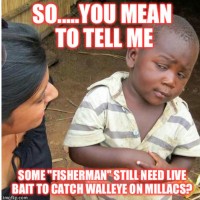Is it April 1st again? What about the cane poles?
Live bait will be allowed on Mille Lacs Lake starting with opener
(Released April 7, 2016)
DNR works with local advisory committee to reconsider live-bait restriction
All Mille Lacs Lake anglers will be able to fish with live bait when the season opens Saturday, May 14.
“This year’s Mille Lacs regulation will not include a live bait restriction due to feedback from anglers and stakeholders,” said Don Pereira, fisheries section chief for the Minnesota Department of Natural Resources. “The DNR is hearing that anglers are accepting of the catch-and-release aspect of the walleye season, but members of the Mille Lacs Fisheries Advisory Committee heard clear concerns about the live bait restriction, as did the DNR.”
The DNR decided to allow live bait after committee members and the DNR met Wednesday, April 6, and had a productive discussion about the pros and cons of the live-bait ban.
“Our discussion showed the DNR and the committee are determined to work together to protect the resource while still providing the best recreational opportunities on Mille Lacs for a wide range of users,” said Dean Hanson, who operates Agate Bay Resort in Isle and co-chairs the advisory committee.
All other Mille Lacs regulations announced March 21 remain in place, including the provision that requires all walleye caught to be immediately released.
The new regulations come as the DNR is working to conserve young walleyes so they can mature and become spawners, thus helping the lake’s walleye population to recover. Hooking mortality – an estimate of the number of fish that die after being caught and returned to the water – is a factor in keeping state anglers under this year’s state walleye allotment.
Hooking mortality increases as water temperatures warm and catch rates increase. Both factors are at play in Mille Lacs this year. Studies show anglers using only artificial bait can reduce hooking mortality substantially because fish are less likely to swallow artificial bait and suffer internal damage from a hook.
Pereira said the initial decision to include a live-bait ban for Mille Lacs regulations reflected the desire of anglers and area businesses to keep walleye fishing open as long as possible.
Removing the live bait restriction does not pose any conservation risk because the state’s walleye allotment of 28,600 pounds established by the DNR and eight Chippewa bands remains in place. A federal court decision requires that walleye fishing on Mille Lacs be suspended if anglers exceed the limit.
Anglers and the Mille Lacs Advisory Committee members said live bait is an important part of the Mille Lacs fishing experience. Concerns about the live-bait ban were expressed locally around the Mille Lacs community as well as from members of the public visiting the Northwest Sports Show, which concluded April 3.
DNR staff learned that it would be difficult for some anglers to adapt to using only artificial bait, and it could particularly discourage young anglers. Bobber fishing with live bait has a long tradition on the lake. Those concerns prompted Wednesday’s meeting between the DNR and the Mille Lacs Lake Advisory Committee.
Hanson said he believes this discussion shows the advisory committee process is working. “We focused on prolonging the walleye season as long as possible by whatever means were available,” said Hanson. But stakeholders told the committee they found the live bait restriction objectionable.
Pereira agreed that the advisory committee process is working well. “The framework was established to communicate information from the public to the DNR, and that’s exactly what happened,” he said. “The committee’s leadership and commitment were crucial to the DNR’s decision-making process.”
Information about Mille Lacs Lake is available on the DNR’s Mille Lacs Lake Web page.
